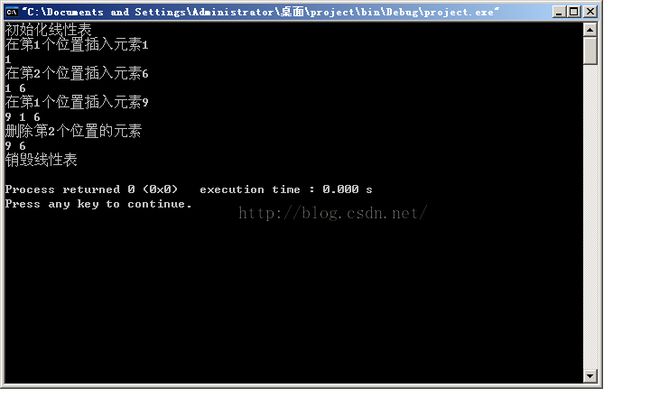第三周——项目2建设“顺序表”算法库
/*
* Copyright (c++) 2015 烟台大学计算机学院
* All right reserved.
* 文件名称:creat2.cpp
* 作 者: 商文轲
* 完成日期:2015年9月21日
* 版 本 号:v1.9
*
*问题描述:请采用程序的多文件组织形式,在项目1的基础上,建立
如上的两个文件,另外再建立一个源文件,编制main函
数,完成相关的测试工作。
*输入描述:无
*程序输出:依据各个函数而定
*/
list.h 是顺序表的算法库集合,里面声明了常用的各个功能函数
#ifndef LIST_H_INCLUDED
#define LIST_H_INCLUDED
#include<stdio.h>
#define MaxSize 50
typedef int ElemType;
typedef struct
{
ElemType data[MaxSize];
int length;
} SqList;
void CreateList(SqList *&L, ElemType a[], int n);//用数组创建线性表
void InitList(SqList *&L);//初始化线性表InitList(L)
void DestroyList(SqList *&L);//销毁线性表DestroyList(L)
bool ListEmpty(SqList *L);//判定是否为空表ListEmpty(L)
int ListLength(SqList *L);//求线性表的长度ListLength(L)
void DispList(SqList *L);//输出线性表DispList(L)
bool GetElem(SqList *L,int i,ElemType &e);//求某个数据元素值GetElem(L,i,e)
int LocateElem(SqList *L, ElemType e);//按元素值查找LocateElem(L,e)
bool ListInsert(SqList *&L,int i,ElemType e);//插入数据元素ListInsert(L,i,e)
bool ListDelete(SqList *&L,int i,ElemType &e);//删除数据元素ListDelete(L,i,e)#endif // LIST_H_INCLUDED
#endif // LIST_H_INCLUDED
list.cpp 对应list.h中声明的各个功能函数,给出了各个功能函数的实现方法。
#include "list.h"
#include <malloc.h>
//用数组创建线性表
void CreateList(SqList *&L, ElemType a[], int n)
{
int i;
L=(SqList *)malloc(sizeof(SqList));
for (i=0; i<n; i++)
L->data[i]=a[i];
L->length=n;
}
//初始化线性表InitList(L)
void InitList(SqList *&L) //引用型指针
{
L=(SqList *)malloc(sizeof(SqList));
//分配存放线性表的空间
L->length=0;
}
//销毁线性表DestroyList(L)
void DestroyList(SqList *&L)
{
L=(SqList *)malloc(sizeof(SqList));//必须写上这一句
free(L);
}
//判定是否为空表ListEmpty(L)
bool ListEmpty(SqList *L)
{
return(L->length==0);
}
//求线性表的长度ListLength(L)
int ListLength(SqList *L)
{
return(L->length);
}
//输出线性表DispList(L)
void DispList(SqList *L)
{
int i;
if (ListEmpty(L)) return;
for (i=0; i<L->length; i++)
printf("%d ",L->data[i]);
printf("\n");
}
//求某个数据元素值GetElem(L,i,e)
bool GetElem(SqList *L,int i,ElemType &e)
{
if (i<1 || i>L->length) return false;
e=L->data[i-1];
return true;
}
//按元素值查找LocateElem(L,e)
int LocateElem(SqList *L, ElemType e)
{
int i=0;
while (i<L->length && L->data[i]!=e) i++;
if (i>=L->length) return 0;
else return i+1;
}
//插入数据元素ListInsert(L,i,e)
bool ListInsert(SqList *&L,int i,ElemType e)
{
int j;
if (i<1 || i>L->length+1)
return false; //参数错误时返回false
i--; //将顺序表逻辑序号转化为物理序号
for (j=L->length; j>i; j--) //将data[i..n]元素后移一个位置
L->data[j]=L->data[j-1];
L->data[i]=e; //插入元素e
L->length++; //顺序表长度增1
return true; //成功插入返回true
}
//删除数据元素ListDelete(L,i,e)
bool ListDelete(SqList *&L,int i,ElemType &e)
{
int j;
if (i<1 || i>L->length) //参数错误时返回false
return false;
i--; //将顺序表逻辑序号转化为物理序号
e=L->data[i];
for (j=i; j<L->length-1; j++) //将data[i..n-1]元素前移
L->data[j]=L->data[j+1];
L->length--; //顺序表长度减1
return true; //成功删除返回true
}
mian.cpp 添加各个函数,以便实现各种功能
#include "list.h"
int main()
{
SqList *sq;
ElemType E;
printf("初始化线性表\n");
InitList(sq);
printf("在第1个位置插入元素1\n");
ListInsert(sq, 1, 1);
DispList(sq);
printf("在第2个位置插入元素6\n");
ListInsert(sq, 2, 6);
DispList(sq);
printf("在第1个位置插入元素9\n");
ListInsert(sq, 1, 9);
DispList(sq);
printf("删除第2个位置的元素\n");
ListDelete(sq,2,E);
DispList(sq);
printf("销毁线性表\n");
DestroyList(sq);
DispList(sq);
}
